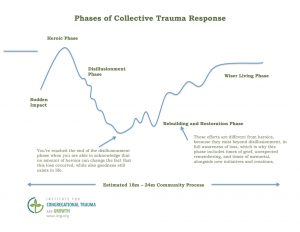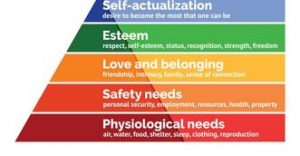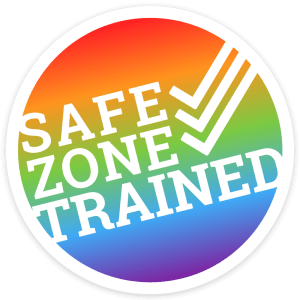When the World Feels Like its Falling Apart a Little (a lot!). Understanding Phases of Disaster Model and 6 Things You Can Do About It Today.
When I transitioned to working from home after the schools closed on March 16th of this year, I was feeling optimistic! I was thinking to myself- I will have quality time with my kids, get a good exercise routine going, see my clients virtually, and maintain a clean home.

Photo by Ben Wicks on Unsplash
Well that idealistic dream burst when I started to realize that triple duty; mom, teacher, and psychologist, within a 12-14 hour day is…..um…..ludicrous! It turns out I’m not alone and there is actually a fair bit of research on this whole responding to pandemics and crisis stuff. I’ve learned a lot over the last couple of weeks and I’d like to share one thing with you all that has helped me gain some perspective.
It is called “The Phases of Disaster Response” or sometimes called “The Emotional Phases of a Disaster Response” and “Phases of Collective Trauma Response”. This model has helped me understand the ups and downs that my family and I have been experiencing as well as given me hope for what might come next.
As I am learning about this model and its 4 phases (heroic, disillusionment, rebuilding and restoration, and wiser living), I have also been considering different ways to cope. This is not a rigid model and everyone’s experience is unique so you may not follow the exact flow of what is described and that is OK!
THE 4 PHASES OF DISASTER RESPONSE

Heroic Phase – The heroic phase generally happens right after a disaster has hit. A disaster such as a crisis or a pandemic. One of the main qualities is a rush of endorphins. It is like having a surge of energy where we take action almost automatically. We jump in, doing whatever we can to help. We can tend to hyperfocus on “necessary” tasks and be in “get it done” mode. This might look like planning schedules for school and work at home during the pandemic, making to do lists, buying lots of toilet paper, and tightening control over things we have a say in. Lists, routines, and planning are the name of the game. We may feel resourceful and come up with creative ways to spend our days with self and family.

Photo by Esteban Lopez on Unsplash
Disillusionment Phase– This is where the endorphin train halts hard! We may notice constantly feeling exhausted, like a burnout of “this too much and there is nothing I can do to make it better”. This usually shows up as physical tiredness and lethargic feelings. It might be hard to get out of bed. Our emotions are running high. We might be feeling grief, stress, helplessness, frustrated, irritated, and these emotions might be wearing us down. Some people may experience different types of feeling like appreciation and gratitude for some of the changes. There can be a sense that there is nothing we can do to change what has happened and that there is no going back to the way it was.

Photo by Tonny Train on Unsplash
Turning– This is not a phase but lies between disillusionment and rebuild/restoration. This is usually described as coming to two truths- one where we acknowledge the loss and grief of the old normal and at the same time feel that there is still good in the world. There may be a balance in productive energy and rest/recovery. We might give ourselves permission to not know everything. We feel a sense of acceptance of some of the more negatively experienced emotions (sadness, confusion, anxiety, frustration, boredom, etc.) and know that there are still positive emotions to be experienced (joy, fun, excitement, gratitude, etc.).
We may miss things from our “normal life” like friends, teachers, routines, learning a certain way, and activities. We may also start to adjust to a “new normal” with new routines, different ways to connect with friends and family, etc.
Rebuilding and Restoration Phase – This phase is considered an action phase. It is one that is collective and collaborative. Families coming together, professionals, community, government, etc. Is it marked by a focus on the “best interest of the most people”. We may see that this phase strikes creativity and an invitation for many voices from the community. This phase takes time and we experience the ups and downs of grief with a sense of moving forward.
Wiser Living Phase – This phase occurs when communities are well into their “new normal”. Families and communities have considered measures and preparation to help with future experiences. There is an acknowledgement of what has changed for people in more permanent ways. There is an awareness of existential questioning and a recognition of our mortality. This phase is an oscillation between scars and healing.
6 THINGS YOU CAN START DOING RIGHT NOW TO COPE

Photo by Ryoji Iwata on Unsplash
1. Recognize this is a collective trauma response – Many of us have heard this or something like this “We are in this together”. As social creatures, knowing we are not alone and that everyone is impacted by this global experience is an important coping strategy. There are others who are badly wishing they could hang out with their friends, go outside, play on their sports teams, and not constantly be frightened of someone they love getting ill.
2. Have a sense of what phase you are in -If you identify where you most closely find yourself in this model, it can help you decide what you need next. For example, if you are in disillusionment, care and rest are so important as well as giving yourself permission to NOT do. Also, knowing where you are right now, might give you a sense of what might be ahead.
3. Everyone’s experience is unique – Know that this model is just a guideline. In some ways this might contradict my second point. It is important to recognize that this is one model with some good information and that our experiences are unique and may not follow a linear path. As a role model of mine often says, “take what fits and leave the rest”.

4. Start with safety (bottom up approach) – If we think of Maslow’s hierarchy of needs, the very basic needs must be met before we can tend to other needs. Our physical needs are first, followed by safety, love and belonging, esteem, and finally self-actualization. Basically we need a roof over our head and food in our belly before we can “desire to be the most we can be”. Think about your physical needs and what you might be needing right now. Are you tired? Are you hungry? Are you staying somewhere that is not safe right now?
Two truths- One where we acknowledge the loss and grief of the old normal and at the same time know that there is still good and hope in the world.
Our nervous systems work the same way. If we start from the bottom-up, we can help kick in our parasympathetic (rest and relax) nervous system. This can help us feel calmer and manage moments that are overwhelming. Start with something simple, like finger breathing (tracing your breath on one hand using a finger from your other hand), finding 10 items in the space where you are that are the colour blue, imagining a calm place and tapping gently from side to side on your upper legs. The more you practice these types of tools, the more automatic they become.
5. Nourish yourself throughout the day -I feel like you can’t overdo this one. Find moments, even slivers, throughout your day that bring calm, well-being, laughter, inspiration, creativity, play, exercise, rest, and more each day. You can begin by focusing on one of those and peppering your day with activities that bring that into your life. If you choose laughter for example, Facetime someone who puts a smile on your face, watch a stand up comedy show, funny cat videos (are those still a thing?), or try not laughs, fake laugh for 10 seconds- and it shouldn’t take long before it becomes a real laugh. Let me tell you by experience it is super contagious to fake laugh, as my 12 year old said between giggles, “stop mom you’re being so weird!”.

Photo by Felix Mittermeier on Unsplash
6. Know your village – Who are the people that you feel good around. Do they live in your home with you? Are they elsewhere? What is about them that makes them important to you? List those people, think about them, and think about ways you are connected to them right now. You might be meeting up on video games or during virtual games nights. You may be part of a WhatsApp or Marco Polo group. You might call them once in a while. You might sit down to a meal together every day. Be intentional about connecting to your village, to your people.
 Chantal Côté (she/her) is a psychologist and teen life coach living in Calgary, Alberta. After over a decade in non-profit and community mental health, Chantal started Pyramid Psychology, a practice dedicated to supporting teens – a population she is constantly amazed by. Chantal is on a mission to help 100,000 teen girls (and their parents) build bulletproof mindsets so they can weather the ups and downs of life. As part of this goal, Chantal has had the privilege of speaking at various events – virtual and live – to support teens and parents.
Chantal Côté (she/her) is a psychologist and teen life coach living in Calgary, Alberta. After over a decade in non-profit and community mental health, Chantal started Pyramid Psychology, a practice dedicated to supporting teens – a population she is constantly amazed by. Chantal is on a mission to help 100,000 teen girls (and their parents) build bulletproof mindsets so they can weather the ups and downs of life. As part of this goal, Chantal has had the privilege of speaking at various events – virtual and live – to support teens and parents.
Outside of this passion, Chantal is often in nature, writing poetry, playing ball hockey and hanging out with her loved ones.
Each week, Chantal writes a blog article in response to issues she hears from the parents and teens she connects with. If you have something you’d like to read more on – email ideas and questions to info@pyramidpsychology.com or DM us via Instagram or Facebook.













